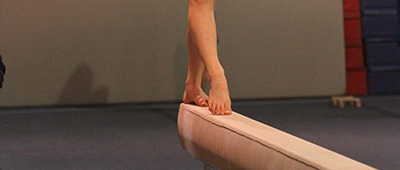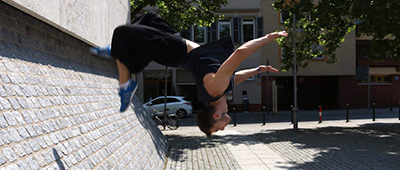Programme
Programme
Current Programme with descriptions (as of 13.05.2024)
Tabular overview with the Programme (as of 13.05.2024)
311001 ‐ Athlete centered training and examples of the preparation for the Olympic Games 2024 in Paris
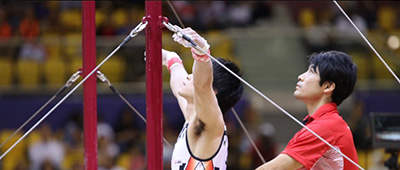
Hiro talks about his experience as national head coach of Japan. Japans team missed Team Gold by 0.103 at the 2020 Tokyo Olympics. After the Tokyo games, he thought improving landing technique is one of the effective ways to win at the games. His approach was to build trust with coaches and athletes first so that everyone can move towards the same direction. He thinks that just giving a training program to the athletes is an easy task to do but making the athletes want to try spontaneously is more important and it is always challenging. His athlete centered approach led to the remarkable results including winning Team Gold at the 2023 World Gymnastics Championships and more.
111006 - Learning to do gymnastics (almost) without spotting: from the backward roll to back extension roll
| When |
Oct 12, 2024
from 09:00 AM to 10:30 AM |
|---|---|
| Where | Halle 2B |
| Attendees |
vorzugsweise C-Trainer |
| Add event to calendar |
|
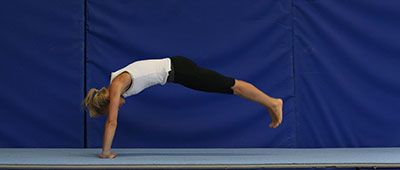
Axel Fries
It's hard to believe, but: many, many coaches, as well as an incredible number of judges, don't even know the characteristics of a back extension roll to Handstand. Often times there are discussions at competitions as to whether the element being shown is a correct back extension roll or not. This will be clearified here. And then we take a short excursion into brain research: the way our brains work tells us how to perform a back extension roll to Handstand without one of the children (or participants) even touching it. Only then it will succeed... The only requirement is the right preparation. As a pre-step, we also show the method for the correct backward roll and a backward roll exercise that can be performed by any child (even overweight ones!)
312011 - Successfully supporting teenagers in elite sport
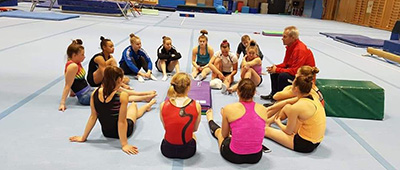
On the door to success is written: Push open AND enter. Our task as coaches is to:
1. prepare and accompany the athletes, so that they open the door with self-confidence and enter.
2. support athletes in a way, that they develop into independent adults alongside a successful sporting career.
What guidelines a coach needs to do is the subject of my presentation.
312004 ‐ How to develop world‐class forward acrobatics?
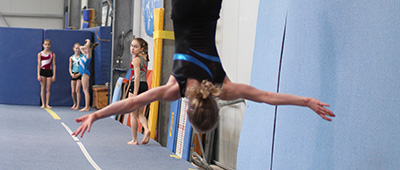
- Physical preparations specific to floor exercise
- Front layout & Front layout in a row
- Front layout with twisting
- How to fix early twisting problem
112006 - Training of basic skills in apparatus parcours: The Gold Seeker Game
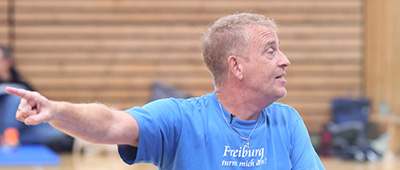
For all types of sports, children need all kinds of conditioning and coordination skills (strength, endurance, speed, dexterity, balance, linking skills, etc.) and - today more than ever - social skills. All of these basic motor skills can be trained with the help of small games or circuit training. What if you could train with children without them even realizing, they were doing endurance training? If the task is to bring gold found in the jungle to the gold mining town and protect themselves from the dangerous monkeys in the process, the children develop unexpected mobility and activity on the one hand, and on the other hand, even children you wouldn't expect suddenly develop very strong social skills and a sense of responsibility for others.
The tasks set are always and without exception aimed at the whole group fulfilling a task and only the whole group can win - or sometimes lose. Children who have experienced such a lesson will tell their friends about it and bring it to the next lesson! But they won't be talking about endurance training, strength training or coordination training, but about pieces of gold, coconuts, mountain gorges and lianas.
112003 - Correctly spotting and guiding at forward somersaults tuck/pike on the Minitramp
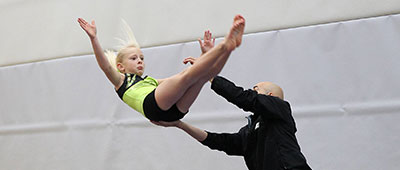
Especially with smaller children (from about 6 years of age), it is worth introducing the somersault backwards holistically - particularly because of their low bodyweight - so that the sense of movement and orientation for this overhead movement develops from a very young age. Certain spotting techniques are predestined for this. However, as soon as the correct jumping technique has been learnt, further spotting techniques must be used. This workshop introduces the various options for active spotting with one or two coaches.
312112 - The Problem of Correct Self-Judgement in Gymnastics
Henning Plessner & Rebecca Smith
In a series of three consecutive studies, female self-judgement and inferred self-judgement in gymnastics was analysed. A total of 125 female youth gymnasts performed a beam routine of their choice which was rated by themselves, expert judges and, in the last study, their coaches. In accordance with previous findings in the field of women’s self-judgement, all studies showed that girls underrated their own sporting performance. Their own score was significantly lower than the experts’ score. When rating other gymnasts, they showed equal scores to the expert judges. Their ratings did not change after receiving visual feedback of their own routine. Coaches were also shown to significantly underrate the absolute level of their own gymnasts, despite a correlation between coaches and experts’ scores. Coaches inferred self-judgements showed no correlation to the athletes’ actual self-judgements.
In total, these studies show different biases and errors in self-judgement and inferred self-judgement in gymnastics. This highlights that further research and targeted interventions in this field are needed.
312212 ‐ Muscle activity in different conditioning exercises for the front lever and full planche
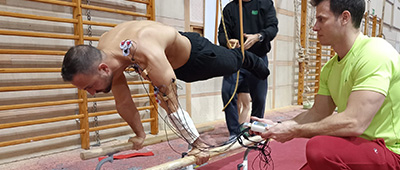
Michel Marina & Priscila Torrado
We assessed muscle activity when doing the front lever and full-planche in different conditions habitually chosen to train the specific strength conditioning of these two gymnastic strength difficulties.
To fulfill this objective surface electromyography (sEMG) was used over the muscles considered as the main agonists. For the front lever we monitored the Latissimus Dorsi (LD), Teres Major (TM), posterior head of the Deltoid (DP), short head of Biceps Brachii (BB), long head of Triceps Brachii (TB), lower part of the Trapezius (TRLOW), the clavicular part of the Pectoralis Major (PMCL), and the abdominal head of the PM (PMABD). On the other hand, for the full planche we put sEMG electrodes over the anterior head of the Deltoid (DA), upper part of the Trapezius (TRUP), clavicular part of the Pectoralis Major (PMCL), short head of Biceps Brachii (BB), long head of Triceps Brachii (TB), extensor digitorum (ED), Flexor Superficialis Digitorum (FD) and Brachioradialis (BR).
Nine testing situations selected for the front lever: 1) Maximal isometric voluntary force (MVFISOM) in static shoulder extension on a methodological bench strength in supine position, 2) Static Shoulder extension in prone position on a balance beam, 3) Dragon Flag with hands gripped on the espalier wall bar, and front lever performed in four different situations like 4) High-bar 5) Rings under FIG requirements 6) Rings with one extended leg and the other flexed, 7) Rings with legs extended but abducted /separated. The front lever on the ring situation and FIG requisites was considered as the reference situation for normalization of the sEMG signal. The testing situations chosen for the full planche were: 1) MVFISOM in Handgrip, 2) MVFISOM of shoulder flexion in supine position, 3) MVFISOM Shoulder flexion in standing position, 4) Full planche in parallettes bars assisted with elastic band, 5) Planche on parallettes bars in tucked position, 6) Planche on parallettes bars in tucked position but one leg extended, 7) Open hip straddle on parallettes, 8) Open hip straddle on the rings.
The two last testing situations served to normalize the sEMG signal. MVFISOM was measured with a force gauge. In both studies body segment angles were supervised in order to be as similar as possible to the reference situation and according to FIG rules. Measurement of sEMG activity proved to be a useful method to quantify and discriminate the neuromuscular demand of different types of strength training exercises oriented to learn distinct types of strength gymnastics element on the rings.
313004 ‐ C Elements and higher on parallel bars
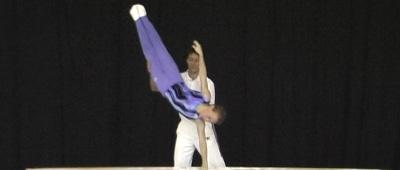
This workshop deals with more advanced skills on parallel bars. Starting with apparatus specific physical preparation, we’ll go through advanced support skills like Healy, Diamidov and Morisue, further on to hanging skills like Giant and Tippelt-alike movements and finally to different types of dismounts.
213015 - (Bar-) Transition skills
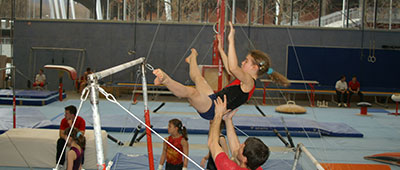
In this practical workshop, the performance requirements and methodology are developed, as well as possible errors and how to correct them.
1. Underswing with 1/2 turn form the higher to the lower bar.
2. Counter swing from the lower to the upper bar.
213011 - `Resilience in Sport` - how to develop your own leadership personality as a coach in competitive and popular sport
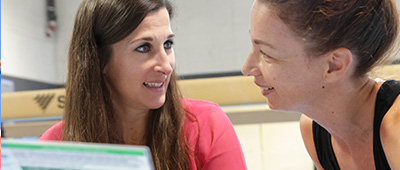
Resilience is so much more than the frequently cited ability to resist. Gain in-depth insights into the 4 levels of resilience: physical, mental, emotional and spiritual resilience. Recognize the extent to which dealing with this multifaceted topic can enrich your professional work and enhance your leadership personality as a trainer. develop your leadership personality as a Trainer or instructor. The workshop shows how your professional expertise can be expanded. With interdisciplinary topics and how your personal skills can be enhanced.
213003 - Hula twist, til twist & Co.
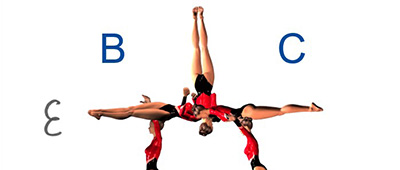
In Trampoline gymnastics, twist movements are incorporated into even the simplest elements and combined with the width axis at a low threshold. This is why the trampoline also serves as a ´prop medium´ for other compositional sports (including artistic gymnastics). In this workshop, the three different types of twist techniques will be introduced, explained in detail and, if necessary, tried out.
113006 - Learning to do gymnastics (almost) without spotting: back handspring
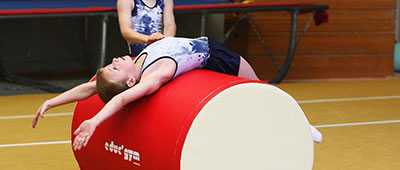
Jumping backwards requires a high degree of courage and body awareness In addition, important preparations are needed to be done before the back handspring. Without those preparations it will simply be impossible to realize a proper back handspring.
In this workshop, important preparation tasks as well as a very interesting, methodical approach are shown, which enables the children to perform the very important multiple repetitions on their own and without help after a short introductory phase. Backw handspring almost alone? Yes, that's possible...
Then we go on to show how to perform a back handspring from the round-off instead of a standing position. Assistance takes a back seat with this method - but you can't jump backwards without it.
314001 - Teaching movements - I: Dealing with different forms of anxiety in gymnastics training
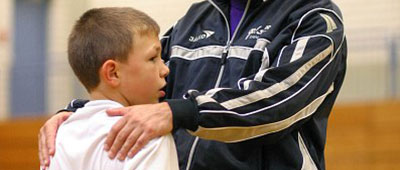
Fears are omnipresent in gymnastics an can affect both gymnasts and coaches. A common strategy is crucial in order to learn how to deal with these fears. It is crucial to realise that "fear" ist not just "fear". Within the framework of this workshop, we want to become aware of different forms of anxiety on a research-led basis and workout together how certain forms of anxiety can be handled in training and competition practice.
214003 - Rotation directions in trampoline gymnastics: observe, identify and set
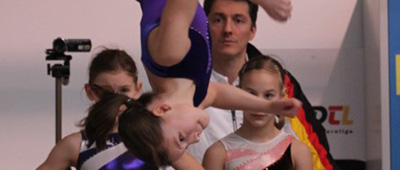
In Trampolining - as in most other compositional sports - a twisting direction is determined quite early on, although the athletes have not yet gained much experience in overhead movements. This decision is usually made by the coach or left to the athletes themselves. But what is behind this?
Behind someone becoming a so-called "right-hand twister" or "left-hand twister"? This workshop takes critical look at the common "rules of thumb" for determining the direction of twisting.
Gymnasts taking part in the workshop should be able to swing up into a handstand, roll backwards, perform a safe forward handspring and optionally a forward somersault with 1/2 twist on the Minitramp.
114006 - Introduction of the mini trampoline as a jumping aid and mini trampoline an a completely different way (including the methodical series for somersaulting on the mini trampoline)
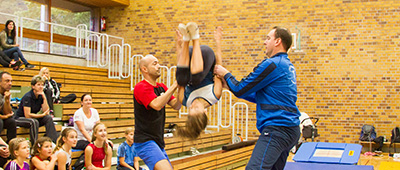
The mini trampoline is often used in schools and clubs as a fun factor. It seems that the same jumps are performed all over Europe (all over the world!?): stretch jump - tuck jump - straddle jump - straddle angle jump - "small roll" - "big roll" - somersault. Firstly, this gets boring, but secondly, its very dangerous, especially because of the big roll and the somersault. Here I will show you how you can use the mini trampoline with other jumps, with even more fun, but first of all in a much more sensible an safer way. The training of the most important preparations for the mini trampoline (e.g. body tension) the correct jumping technique and arm control, small games on the trampoline and then the fun-focussed jumping on the mount mat with the various forward and backward jumps to the methodical series of forward somersaults (without spotting!!!) are also shown here.
214011 - „Master of the situation“ - How to skilfully get a grip on emotions in everyday life, training or competition through emotion regulation
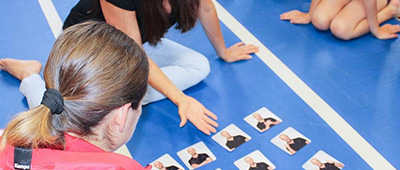
Emotions are part of everyday life. They are normal, everyone goes through them. Especially in turbulent times, however, the emotional states of our selves and our participants can run wild. We fluctuate between anger, rage, frustration, sadness, surprise, joy and fear in various forms of expression. The more precisely I recognise emotions, the better I can resolve them using simple and valuable physical techniques and thus make a significant contribution to the personal well-being and stress regulation of my counterpart.
321015 - Teaching movments - ll: Spatial orientation - What coaches should know and what it is better not to tell athletes
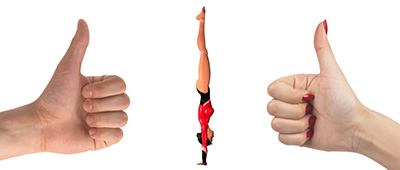
The sport of artistic gymnastics is largely characterised by its three - dimensiobality and the experience, learning and controlling overhead situations. When learning movements and also from the coach‘s perspective in the course of teaching movments, challenges need to the be overcome in this regard (for example, of rotation around the visual perception of a direction of rotation around the longitudinal axis). visual perception of the direction of rotation around the longitudinal axis). In this workshop, key challenges in this area will be addressed in a research-led manner and solution strategies for training practice will be developed.
121006 - Learning spotters moves with children and teenagers including „forward somersault" and backwards just simply…“
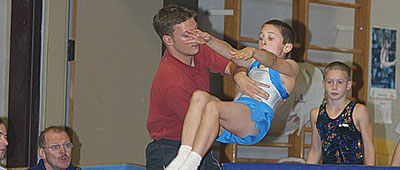
Who doesn‘t like to somersault? Both elements (fwd. and bwd.) are great fun on the floor but only the right technique makes the jumpes safe. the backward somersault is technically a little easier than forward somersault. However, jumping backwards without turning round first is an important pre-skill. Some preliminary exercise are shown for this.
The forward somersault can gain height very quickly with the right technique and the right arm position alone, which is very often done incorrectly. In this workshop, both methods, which largely work without spotting and which quickly lead to success if practised frequently enough, will be shown.
121003 - Varied, inclusive forms of play with and without equipment on the trampoline
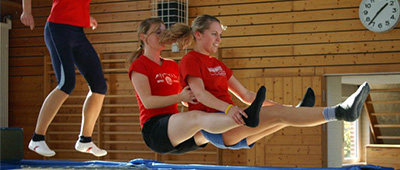
In this workshop, tips and tricks for young and old (beginners and advanced; as well as for people with and without disabilities) on the trampoline and mini-trampoline are demonstrated. Although the focus is on inclusivity, fun and safety are not neglected. Numerous forms of play are offered with and without materials.
322001 - Teaching Movements- lll: Using effect-controlled motor skills in training
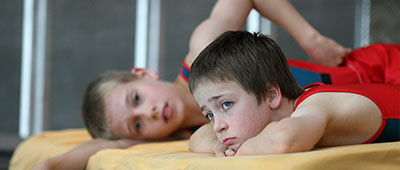
The initiation and promotion of motor learning processes is a central training task for coaches in artistic gymnastics. It is not uncommon for us to find that learning processes can stagnate after a certain level of learning, that our movement instructions cannot be implemented by the gymnast or that methodical measure are suggested to use in the context of further training that can hardly be implemented in our training practice. One keyword that may be helpful in countering these problems is „effect-controlled motor skills“. In this workshop, we will examine what this (very scientific-sounding) term is all about and to what extent we are already using it in our training practice (possibly without realising it.)
222010 - Coaches personality - Because every coach is also a „person“, even if the athletes are paramount
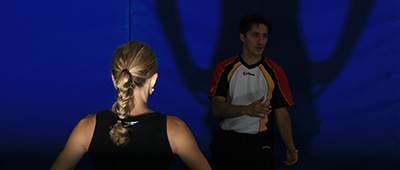
Training, coaching and supporting athletes is a wonderful job. It requires a lot of responsibility and expertise. Sometimes you may reach your own limits, find it difficult to reach the athlete or fail to achieve what you want to achieve or work for. Then you are left with thoughts or even worries about the athlete and at the same time your own issues that you have to deal with. This is where (self-)reflection, valuable exercises and further development of your own communication and mediation skills can help. The workshop is aimed at interested coaches who are open to new ideas and expanding their own repertoire.
222003 - Longitudinal rotation directions in trampoline gymnastics: observe, determine and define

In Trampolining - as in most other compositional sports - a twisting (longitudinal rotation) direction is determined quite early on, although the athletes have not yet gained much experience in overhead movements. This decision is usually made by the coach or left to the athletes themselves. But stands behind this?
Behind someone becoming a so-called "right-hand twisterr" or "left-hand twister"? This workshop takes critical look at the common "rules of thumb" for determining the direction of twisting.
Demonstrating gymnasts should be able to swing up into a handstand, roll backwards, perform a safe forward somersault and optionally a forward somersault with 1/2 twist on the Minitramp.
313112 - Gymnasts’ routines' heart rates should not be compared to their heart rates measured during graded maximal exercise tests
Authors have endeavoured to compare heart rates recorded during gymnastics routines with those obtained during a VO2 max test. However, we assert that such a comparison lacks both logical and scientific validity. Gymnastics routines, such as a pommel horse routine, engage distinct muscle groups, contractions, and skill sets. A gymnast bears their body weight and executes manoeuvres primarily using their hands, with their body often maintained in an isometrically contracted state throughout the routine. Conversely, a graded VO2 max test typically involves cycling or running on a treadmill.
In our forthcoming presentation, we will expose the foundational physiological and metabolic principles that delineate gymnastics routines from graded running or cycling exercises.
313212 - Body characteristics and gymnastics activity
Gymnastics was established as competitive activity in 1903 at the World Championship in Antwerpen. Gymnastics disciplines in that time were some free disciplInes (track and field disciplines – what is today known as athletics), apparatus disciplines (rope climbing, weight lifting and artistic gymnastics) and swimming. After more than 100 years some disciplines have been removed, some activities were taken and are guided by some other federations. Gymnastics family of disciplines also changed. Nowadays FIG governs artistic gymnastics, trampolining, rhythmics, aerobics, acrobatics, parkour and gymnastics for all. In an educational area in schools within P.E. all previous named disciplines in some form are performed. Body characteristics of those who practice gymnastics changed, according to personal needs on one side and on other side as influence of gymnastics activity. Boundaries of healthy or competitive gymnastics activity can be discused from different frames.
314112 - Gymnastics coach education challenge: review of the in-person, online and hybrid model

The last decade has brought significant changes to coaches' education, including an exponential growth in digital platforms. Thus, we analyzed the contributions and limitations of the educational models used to train sports coaches (in-person, remote and hybrid).
314212 - Children in high performance gymnastics – can there be a child-wellbeing and child centered approach?

Social media is replete with images and videos of incredible levels of skill (not just in gymnastics) achieved by pre-adolescent children. This delivers a false message to coaches and parents that such achievements are worthy and desirable and should be emulated. It sends a message of the need for hyper-early specialization and early high volume and intense training so that such skill levels can be attained. But is this necessary? Is this in the interests of the children’s wellbeing? Does it translate to future high-performance success?
I will argue that such efforts, though great for social media “clicks and likes” and envied by the easily impressed, are counterproductive and often damaging in many ways. This presentation will focus on a more rational approach for achieving high-performance success for when such success is significant rather than serving, as it does much too often, only to temporarily impress and shock. The well-being of children and the safe and systematic training towards a successful future serves, not only the children, but also the larger gymnastics community and the reputation and esteem of the sport.
321112 - Physiological and energetic demands in artistic gymnastics

Recent studies in artistic gymnastics suggest that the demands on the cardiorespiratory and metabolic system are greater than previously assumed, both in training and especially in competition. Especially the aerobic metabolism shows with 54% on the floor and 29% and 23% on the rings and pommel horse a greater relevance than previously assumed. The development of an optimal energy supply and thus the gymnastics-specific endurance capacity is one aspect of successful performance. High Intensity Interval Training (HIIT) offers one way of optimising energy supply and thus increasing gymnastics-specific endurance performance. HIIT is a training method that consists of short, high-intensity exercise intervals interspersed with short rest periods. Depending on the desired training effect, the HIIT variables, intensity and duration of the exercise intervals as well as the rest period, can be varied.
In this presentation, as a first step, the physiological energetic demands of artistic gymnastics will be discussed. Furthermore, a training intervention study will be presented and discussed which investigated the effects of semi-specific HIIT on energy supply and specific endurance performance on the floor and pommel horse.
321212 - Why developing physical conditioning routines with flywheel devices can improve the vertical jumping capacity in gymnastics

Description
Implementing physical conditioning programs with flywheel devices (FD) improved significantly the strength and power of the inferior limb musculature in teams sports [1], such as volleyball [2], soccer [3], football [4], and handball [5] among others. On the other hand, this kind of training also demonstrated positive strength and power effects in individual sports as tennis [6] and in subjects experienced in strength training [7]. Nevertheless, FD training should not be considered as replacement of other traditional resistance training, but as a supplementary and complementary method to enhance the jumping performance [8].
Nowadays, general recommendations to induce chronic adaptations in research and applied contexts are the following [9]: 1) Selecting an overall range of inertial intensities around 0.05–0.11 kg·m2 to improve athletic performances [3, 10]; 2) Adopting training protocols with multiple sets (from 3 to 6) and repetitions (from 6 to 8) [3, 11]; 3) A frequency of 2–3 sessions/week completed for 5–10 weeks [11].
The above-reported improvements of the strength and power parameters of the inferior limb seem to be explained by an augmented eccentric muscle contraction (descending phase) thanks to the overload originated by the accumulated inertia during the concentric phase (against gravity) as long as the upward squat is executed at maximal effort [12]. Under these conditions the main physiological effects are [12, 13]: 1) increment of the number of attached cross-bridges and potentiated tensile contribution of the passive structure elements engaged within the sarcomere under elongation/lengthening, 2) preferential recruitment of high threshold motor unit and greater cortical activity, 3) Acute morphological muscle adaptations induced by structural damage at muscle level where the overstretched sarcomeres become progressively weaker and disrupted [14].
It is time to do applied research in artistic gymnastics and gymnastics in general to optimize the benefice already reported in other populations.
References:
1. Buonsenso, A., et al., A Systematic Review of Flywheel Training Effectiveness and Application on Sport Specific Performances. Sports, 2023. 11(4).
2. Wang, J., et al., The effect of flywheel complex training with eccentric-overload on muscular adaptation in elite female volleyball players. PeerJ, 2024. 12: p. e17079.
3. Coratella, G., et al., Effects of in-season enhanced negative work-based vs traditional weight training on change of direction and hamstrings-to-quadriceps ratio in soccer players. Biology of Sport, 2019. 36(3): p. 241-248.
4. Timmins, R.G., et al., Sprinting, Strength, and Architectural Adaptations Following Hamstring Training in Australian Footballers. Scand J Med Sci Sports, 2021. 31(6): p. 1276-1289.
5. Sabido, R., et al., Effects of adding a weekly eccentric-overload training session on strength and athletic performance in team-handball players. Eur J Sport Sci, 2017. 17(5): p. 530-538.
6. Canos, J., et al., Effects of isoinertial or machine-based strength training on performance in tennis players. Biol Sport, 2022. 39(3): p. 505-513.
7. Walker, S., et al., Greater Strength Gains after Training with Accentuated Eccentric than Traditional Isoinertial Loads in Already Strength-Trained Men. Front Physiol, 2016. 7: p. 149.
8. Arsenis, S., et al., THE EFFECTS OF FLYWHEEL TRAINING ON THE STRENGTH AND POWER OF LOWER LIMBS. Sport Science, 2019. 12(2): p. 8-19.
9. Beato, M. and A. Dello Iacono, Implementing flywheel (isoinertial) exercise in strength training: current evidence, practical recommendations, and future directions. Frontiers in Physiology, 2020. 11: p. 569.
10. Maroto-Izquierdo, S., et al., Comparison of the musculoskeletal effects of different iso-inertial resistance training modalities: Flywheel vs. electric-motor. Eur J Sport Sci, 2019. 19(9): p. 1184-1194.
11. Maroto-Izquierdo, S., et al., Skeletal muscle functional and structural adaptations after eccentric overload flywheel resistance training: a systematic review and meta-analysis. Journal of Science and Medicine in Sport, 2017. 20(10): p. 943-951.
12. Douglas, J., et al., Eccentric Exercise: Physiological Characteristics and Acute Responses. Sports Med, 2017. 47(4): p. 663-675.
13. Hody, S., et al., Eccentric Muscle Contractions: Risks and Benefits. Front Physiol, 2019. 10: p. 536.
14. Illera-Dominguez, V., et al., Early Functional and Morphological Muscle Adaptations During Short-Term Inertial-Squat Training. Front Physiol, 2018. 9: p. 1265.
321005 - C elements and higher on rings
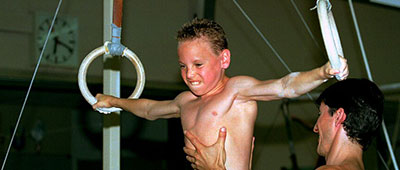
This workshop deals with more advanced skills on parallel bars. Starting with apparatus specific physical preparation, we’ll go through strength elements like Swallow and Honma to cross, further on to swing skills like Yamawaki and Guzogey type elements and finally to different types of dismounts.
322112 - Diet, nutrition, and supplementation in male and female gymnasts – the good and the bad
In gymnastics, external appearance holds significant importance. Female gymnasts, including rhythmic gymnasts, face numerous pressures, including those from coaches and judges who emphasize aesthetics and weight. These pressures often lead to severe dietary habits, resulting in negative energy balance and increased risks of eating disorders.
Studies consistently highlight the prevalence of eating disorders among gymnasts, with detrimental effects on performance and increased injury risks. Male gymnasts also face challenges with inadequate energy consumption despite high expenditure, though to a lesser extent.
In this presentation, we will expose some of the previous and current weight management, diet habits, deficiencies, and supplementation in gymnastics.
322212 ‐ From Movement to Social Connection: Gymnastics as a Key to Better Aging
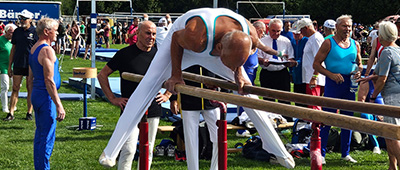
Karmen Šibanc & Maja Pajek
As populations age, the need for effective strategies to maintain health and well-being in older adults becomes increasingly vital. Gymnastics, traditionally seen as a sport for the young, is proving to be a powerful tool for enhancing the physical and mental health of seniors. This presentation will explore the significant benefits of regular participation in apparatus gymnastics for older adults. Regular gymnastics practice boosts muscle strength, flexibility, balance, and coordination, all critical in preventing falls and maintaining independence. Beyond the physical benefits, gymnastics also plays a key role in improving mental health by reducing loneliness and fostering social connections. Group-based gymnastics programs create a supportive environment where participants can bond over shared experiences, enhancing their overall quality of life. The presentation will highlight how gymnastics can be adapted to suit the needs of older adults, ensuring safety while still offering challenges that lead to meaningful health improvements. The session will also discuss the broader public health implications of incorporating gymnastics into strategies for healthy aging, offering insights for healthcare providers, fitness instructors, and policymakers. Attendees will gain a deeper understanding of how gymnastics can serve as a transformative force in promoting longevity and well-being among seniors, making it a valuable addition to any comprehensive health plan for aging populations.
122006 - Learning gymnastics (almost) without spotting: vault l - preliminary exercises for the support jumps that everyone knows and everyone does wrong
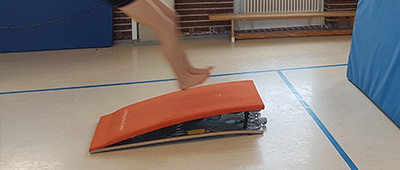
Who has ever tried to teach children how to jump on a springboard? Who has almost despaired? That‘s right, we‘ve all been there. Two-legged jump on the board, only running over it… All the variations can be seen - but not the right one. Once you start explaining, it‘s all over. Here, very small tips and tricks with a very big effect are shown, how the children learn the jump on the springboard „as if themselves“, at the same time strengh training for all support jumps are included in the programme and the preparation of the correct landing position after jumps and dismounts. In addition, some preparatory exercises are shown that are „real“ pre-exercises. And we finally put an end to „the hot hob“ because that‘s wrong. And then there‘s an amazing bet: the instructor bets that all participants will do a squat turn over the gymnastics bench (yes, the squat turn that everyone knows) incorrectly!!! But of course he also shows how a simple trick can turn the squat turn into a very effective pre-exercise for the support jumps. We promise: it will be very exciting! This is the first part.
323001 - Coach-Athlete relationship and examples of the preparations for the Olympics Games 2020 in Tokyo
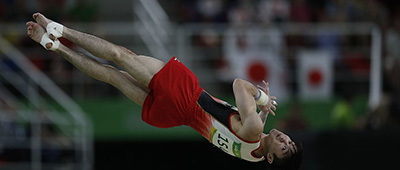
Hiro talks about his journey with Kohei Uchimura, a two-time Olympic champion, six-time World champion. Being a personal coach of one of the greatest gymnasts was an invaluable experience. However, Hiro was presented with a lot of challenges leading up to the 2020 Tokyo Olympic Games. He talks about how the coach-athlete relationship
with Uchimura looked like and shares his coaching philosophy.
223010 - Embodiment & resilience - how to stand firm physically and mentally in wild times
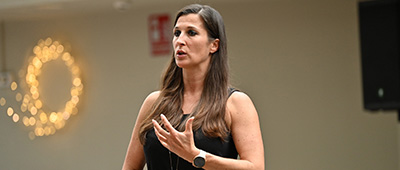
The current times challenge our individual resilience. We have to stand firm, remain steadfast in (working) life, overcome difficulties in the best possible way and overcome crises. Resilience is high demand! It seems as if the topic of „inner and outer resilience“ is more explosive than ever. Exciting results from embodiment research show how I can achieve positive emotions through targeted body postures. Scientific background knowledge is combined with practice that is easy to transfer to everyday life.
123007 - Parkour I
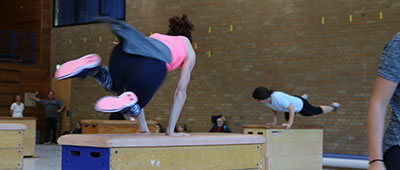
The basic parkour course covers the basics of the sport: jumping, landing and first jumps over obstacles. The elements are learned consecutively and put together in a playful way at the end. The course is suitable for anyone interested in the sport of parkour.
123006 - Learning gymnastics (almost) without spotting: Vault ll - methodology for straddle jump, tuck jump, forward handspring on vault
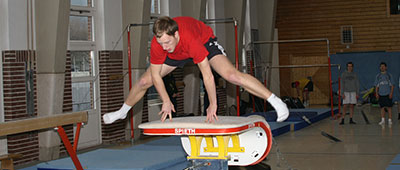
The correct preliminary exercises and the correct take off on the springbord have already been shown in Part 1. We continue with the methodical series on the straddle jump and squat jump up to the forward handspring. Fun - orientated exercises are shown here, in which the children practise almost always without spotting, at the same time as bulidingup the nessessary strength and learning the correct technique for pushing an the apparatus. And they learn that there is no such thing as a “push-off“ in the support jumps, but that it works in a completely different way. Who has ever heard the term „hot plate“ in connection with the jump? That‘s exactly right here. It is switched off very quickly and forever!!!
123003 - Correctly spotting and guiding a forward somersault tuck or pike on a minitramp
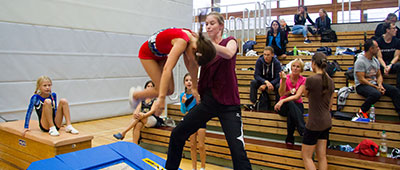
Especially with smaller children (from around 6 years of age), it is worth introducing the somersault forward in its entirety- particulary because of their low body weight - so that the sense of movement and orientation for this overhead movment are right from a very early age. Certain spotting moves are predestined for this during active spotting. However, as soon as the correct jumping technique has been learnt, further spotting techniques must be used. This workshop introduces the various options for active spotting with one or two instructors.
324015 - C elements and higher on high bar
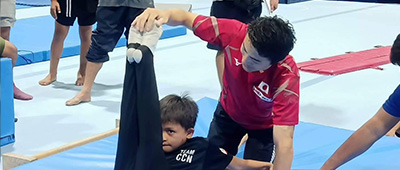
This workshop deals with more advanced skills on high bar. Starting with apparatus specific physical preparation, we’ll go through long hang swing elements like Quast, further on to famous release skills like Tkatchev and Kovacs, on to Inbar skills, especially Adler type elements and finally to dismounts.
224003 - Cat twist, tilt twist & Co.

In Trampoline gymnastics, twists movements are incorporated into even the simplest elements and combined with the width axis at a low threshold. This is why the trampoline also serves as a ´prop medium´ for other compositional sports (including artistic gymnastics). In this workshop, the three different types of twist techniques will be introduced, explained in detail and, if necessary, tried out.
124007 - Parkour ll, middle level
The second Parkour class covers more advanced jumps. Depending on the level and experience of the participants, various turns and somersaults (such as the palm spin, wall spin, wall flip, B kick and B twist) from parkour, including their didactic series will be demonstrated. Suitable for those interested in getting to know or enjoying advanced parkour training.
224011 - Training planning: knowing how
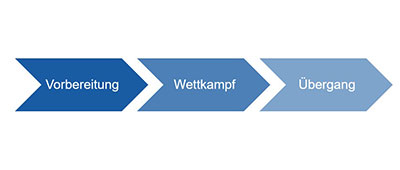
How do you plan a season: apparatus training, physical and mental preparation, stress and recovery phases, with the aim of allowing the athletes to start the main competition of the year with the feeling: Show time! Using a practical example, I will explain how I have often been able to successfully fulfil this most important task as a coach togehther with the gymnasts.
This workshop is for all colleagues who prepare competitions. The basic principle can be used at any level.
124006 - Learning gymnastics without spotting: From cartwheel to handstand? Handstand to cartwheel?
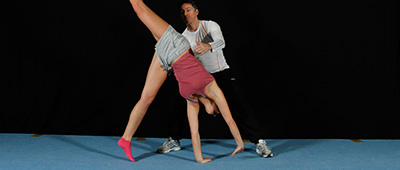
Which order is the right one? How do I give children the necessary support? How do children get the nessesary body tension? How do I ensure that the children do not run forwards with teir hands when lifting themselves up into a Handstand? What methodes do I use? How do the children get their legs upright when doing wheel? How do they learn the correct body rotation in the direction of movement after the wheel? How are the hips, knees and toes stretched when doing a cartwheel? What does toilet paper have to do with the cartwheel? Lots of questions? This workshop has the answers. All of them? All of them! And: everything works without help!!!


